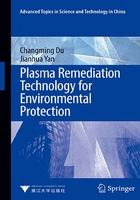
Chapter 2 Remediation of Phenanthrene-contaminated Soil Using Non-thermal Plasma Fluidized Bed
Abstract: A non-thermal plasma fluidized bed (PFB) was developed for remediating phenanthrene (PHE)-contaminated soil. After a 25-min treatment, 95% of the PHE was removed with an energy density of 5960 J/g soil, air flow rate of 20 L/min, and soil moisture of 10%. The effects of the solid bed location, energy density, the flow rate, and the carrier gas were explored. It was found that decreasing the distance between the solid bed and electrodes properly and increasing the input energy density were favorable for PHE degradation. There existed appropriate flow rate and soil moisture for a higher efficiency. By means of various methods, the roles of the active species on the degradation efficiency and the products formed during discharge were analyzed. Possible mechanism of the PHE degradation by the PFB was proposed. Furthermore, a brief comparison with other competitive processes was performed, indicating that the proposed PFB was a promising alternative process for remediating PHE-contaminated soil.
Keywords: Plasma; Fluidized bed; Contaminated soil; Phenanthrene; Remediation